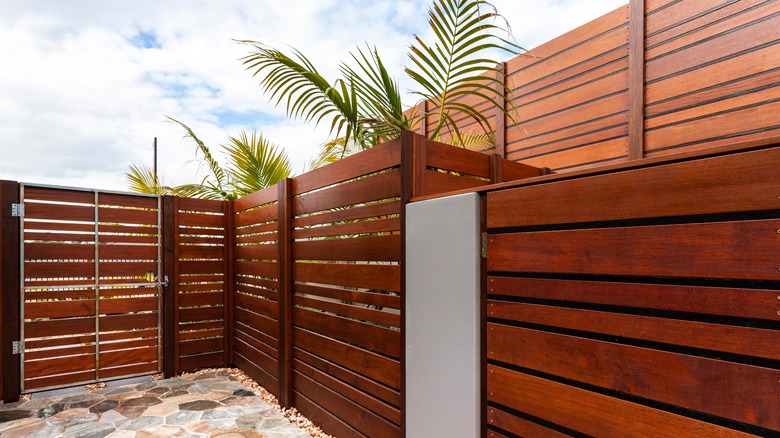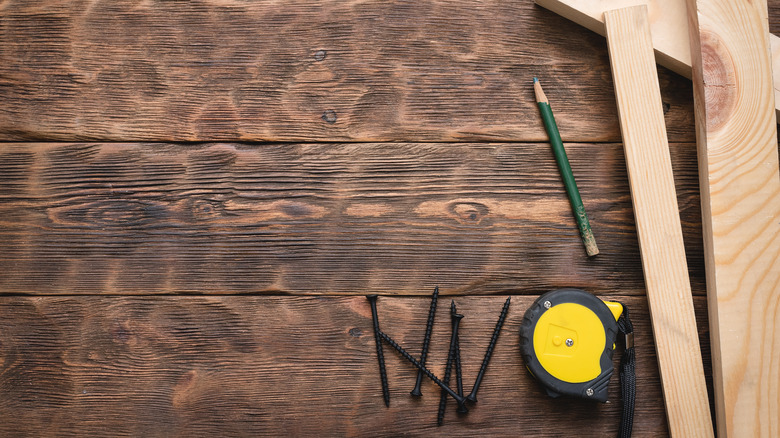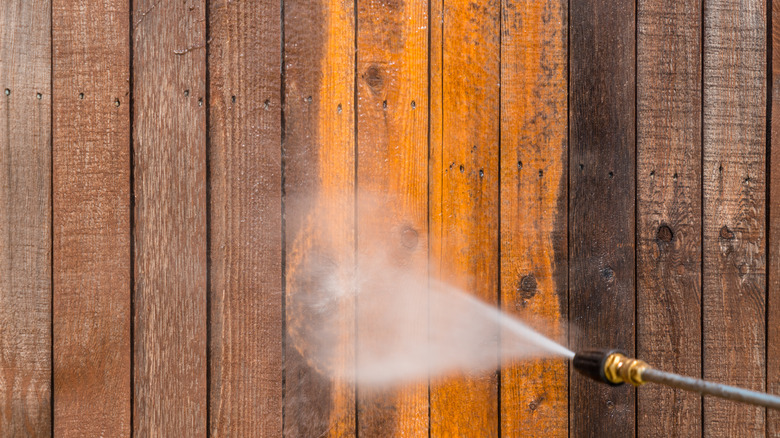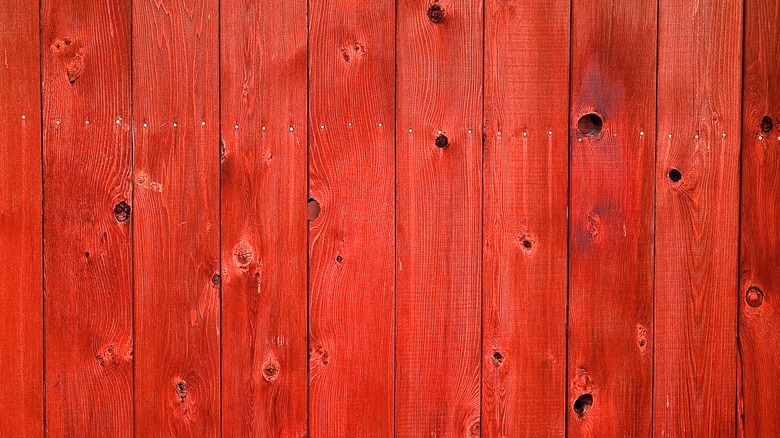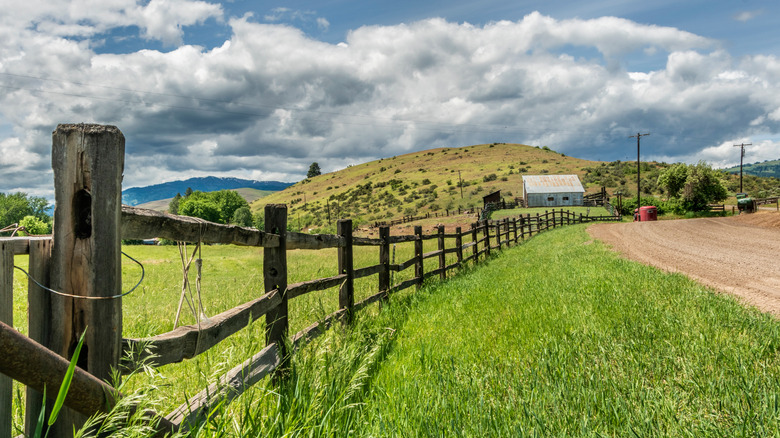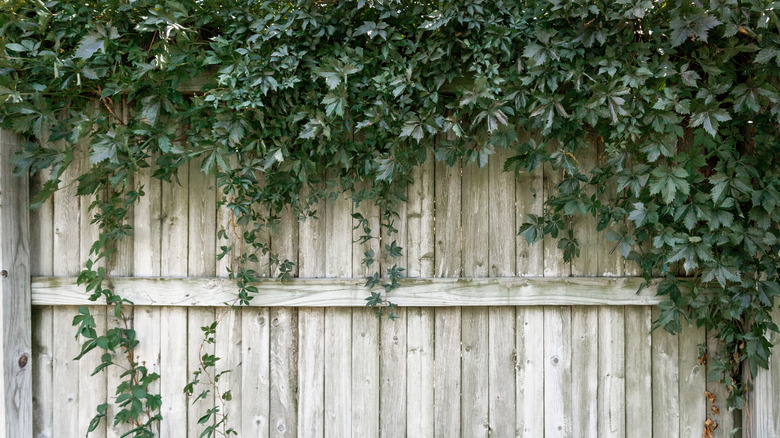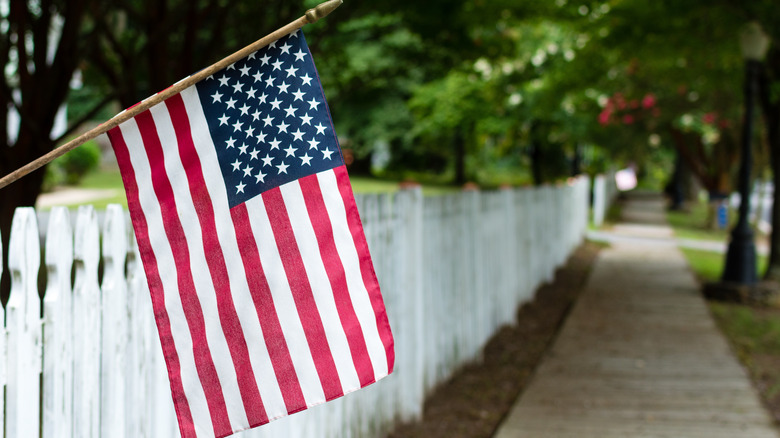How Much Does It Cost To Install A Wood Fence?
Wood is one of the most attractive and popular options when it comes to fencing choices, but there are a lot of different factors that influence how much a wooden fence may cost. Angi reports that the average total cost of installing a wooden fence is usually between $1,600 and $4,115. Wooden fence costs are typically displayed in dollar amounts per foot of fence length. If you plan on installing your fence yourself, you will save some money by only having to pay for the materials, which will run you between $1 and $15 per linear foot of wood. Paying for professional installers will bump that rate up to between $10 and $30 per linear foot.
Almost any kind of wood can be used to build a wood fence, but according to The Spruce, the most common types of wood used in fence building are pine and cedar for cost efficiency and durability purposes. There are a lot of other details to consider when building a wooden fence a wooden fence, though, and you should make sure you take them all into consideration when planning your fence project.
Factors for cost
No matter what kind of wooden fence you are trying to build or what type of wood you are planning to use, there are going to be a variety of basic factors that influence the final purchase price of your new fence. Angi has a good breakdown of many of the basic details that homeowners should think about when embarking on their fence journey.
Fence height and length
It stands to reason that the taller you want your fence to be, and the larger the area you want to be fenced in, the more it is going to cost you -– because obviously, a longer and taller fence will, of course, require more wood. Most fence contractors offer default heights of 4, 5, or 6 feet. If you want your fence to go over 6 feet, which offers the most privacy and protection, you will likely be charged anywhere between 20% and 30% more than for a standard fence height.
If you want a taller fence, it may make more sense to go the DIY route to avoid that additional charge. But if you are looking at installing a particularly long fence, regardless of its height, you will likely want to find a contractor to install your fence for you. The longer your fence, the larger volume of wood you will need, and contractors are usually able to buy their materials in bulk, which lowers the overall cost.
Materials and tools
Constructing a wooden fence requires a ton of materials besides the wood itself, not to mention the tools to work with those materials. The process of building a wooden fence involves drilling holes in the ground for the fence posts, mounting the posts, and then building out wooden slats in between the posts. To drill the ground holes, you will need an auger. A power auger can cost you between $60 and $600, although you can rent one for a daily rate of between $50 and $100. A manual auger is significantly cheaper, usually anywhere between $15 and $110 to buy outright (though it should be noted that whatever a manual auger saves you in dollars, it costs you in blood, sweat, and tears).
Once you have drilled your holes, it's time to fill them. Although you can choose to place your fence posts directly into the ground, the most stable and durable option is to set them in concrete instead. You can buy concrete in bags, usually around 80 lbs., costing $8 to $10 per bag. You will usually need anywhere between one and four bags for each post, depending on how tall and thick your posts are.
Mounting the posts into the concrete and adding the slats for the fence itself will require screws, a drill, drill bits, an air compressor, and a finish nailer. You will need to make sure anything metal that goes into the final fence itself, such as your screws and nails, is made out of stainless steel. According to HomeGuide, any other type of steel, including both galvanized and non-galvanized, will bleed black when it gets wet, leaving deep, unsightly stains on your pretty new wooden fence. Best avoided if at all possible.
Labor
Of course, you could decide not to spend any money on your own tools or materials and instead outsource the building of your wooden fence to a fencing company or independent contractor. While this approach will save you time and likely some cost on materials, your overall cost will probably be higher if you go the contractor route. Most companies will charge you by the linear foot, giving you the quote already mentioned for professional installation: between $10 and $30 per foot. Some fencing businesses, however, may charge you by the hour, usually between $25 and $60 per hour of work. For a fence between 100 and 200 feet long, you can expect between one and three full days of work from your contractors, so they would charge you a total amount anywhere from $200 to $1440.
Another advantage of working with a contractor is that they will usually give you some kind of warranty on your finished fence. That way, if your fence falls apart, rots, is knocked over by a tree or is otherwise damaged, you can receive a free repair or replacement if the event occurs within the warranty period –- not an option if you choose to build your fence yourself.
Location
Depending on where you want your fence to go, you may have to deal with additional costs related to location. If your fence is going to go up or across a hill, you will be charged more for the extra trouble to build –- and in some situations, the hill may be so steep that building a fence on it would be impossible or dangerous, in which case you will need to pay to have the ground leveled. Leveling an area can set you back anywhere from $500 to $5000, according to HomeServe, so think carefully about where you want your fence to go and if it's worth the extra funds.
Other location costs may be less obvious. Digging holes for fence posts is an already laborious task, and it can be made even more complicated by the presence of rocks or clay in the soil. Some contractors will charge more upfront for tricky soil conditions. If your contractor does not charge you upfront, you may still end up paying more for rough soil work if they are charging you by the hour, as it will take significantly longer for them to dig out rocky soil.
Additional costs
Beyond the basics of building your fence, there are a myriad of extra costs you may have to find yourself dealing with, from permits to get your fence off the ground (literally) to staining it once it's done.
Removing your old fence
If you already have a fence in place, whether that is a chain-link fence you are looking to upgrade to something a little more eye-catching, or an existing wooden fence that has seen better days and needs replacing, it will probably cost you more to get your old fence out of the way. Some contractors will include fence removal as part of the overall project, but if not, you can expect to see an additional charge. HomeGuide reports that removing a fence usually averages around $500 in extra costs, depending on the length of your old fence.
Other prep work
Regardless of whether or not you had an old fence to haul out, you will probably need to do some additional prep work before you can start putting your new wooden fence in the ground. If you have trees in your yard, you will probably need to trim the lower branches if they are located near the future fence and potentially even remove some trees entirely. Most contractors will also expect you to mow any grass close to where your fence needs to be before they will start working. Some contractors will prep your yard for you, but none will do it for free.
Permits
Depending on the community you live in, you may need to explore your permitting options before you get started on your new wooden fence project. As mentioned above, any fence that is taller than 6 feet will be over the normal fencing height standard, so a permit could be necessary in that situation. If you live in a neighborhood with a homeowner's association (HOA), your odds of needing a permit go up as well. Most permits cost around $40 per HomeGuide, but the cost of paying a fine if you skip the permit process -– or even worse, removing the wooden fence you had just paid thousands of dollars to install -– is much, much higher, so make sure you double and triple check your permitting situation before beginning installation.
Corners and complications
Ideally, all fences would encompass a nice, standard, square area. But we all know that's not how most yards are. Even if your yard space is geometrically simple, you may want some more complicated features in your fence, like a hidden alcove to store yard supplies. Keep in mind that with every corner your fence incorporates, it will require at least one additional fence post. That is one more hole to be dug, one more set of concrete to be poured, and one more post to be installed. The more corners your fence has, the more it will cost you. If you want some sort of alteration in your fence, like a shorter section to accommodate a growing tree, that will likely run you an additional cost as well.
Gates
Odds are, you are going to want to be able to enter the area you are enclosing in with your wooden fence, and not just from your house's back door. Your fence will probably require at least one gate, whether it be a simple, utilitarian gate for your side yard or a fancier, more ornate gate for guests to enter through your front yard. Gates involve extra posts, once again, as well as hinges, latches, and locks if necessary, so they will cost you more. HomeGuide reports that each gate will set you back about $325 on average.
Staining, waterproofing, and painting
The thing about wooden fences is that you can't just build them and forget about them. Wood is more susceptible to certain types of damage than other kinds of fence materials, so you will likely need to finish your fence with some kind of protective cover once it is built. You can purchase stains that will waterproof your wooden fence and protect the wood from insects and stain the fence yourself, at a cost of around $6 per linear foot, according to HomeGuide. If you add staining or waterproofing to the total fence installation package you are purchasing from a contractor, it will probably cost you closer to $8 per foot.
Of course, you can avoid the whole staining or waterproofing process by instead choosing to paint your fence. You may have other motivations for painting as well, such as to cover a cheaper wood that is more likely to fade over time or because you are looking for that iconic white picket fence look. Painting can be significantly cheaper than staining, with costs running at around $5 per linear foot for a professional paint job, per that same HomeGuide article. But, keep in mind that paint flakes and fades over time, so if you do paint your wooden fence, you are signing up for some level of future maintenance (and future ongoing paint costs).
Types of wood used in fencing
Regardless of all your other costs, the most significant determinant of your wooden fence's overall price comes down to one simple choice: the type of wood you use. The Spruce has a good breakdown of the pros and cons of different kinds of wood, while Angi has helpful information on the price points of each type.
Cypress
Cypress is typically one of the least expensive options when it comes to building a wooden fence, coming in at around $2 per linear foot. Cypress tends to be more resistant to moisture and rotting than other woods, and it is naturally less knotty, which means it has fewer entrance points for insects that could cause future problems. It also contains natural oils that repel insects, although these can wear off over time, so you will likely need to treat it at some point in the future with an insecticide.
Pine
Pine is another cheaper wood choice, usually costing around $3 per linear foot. One of the reasons pine is so inexpensive is because it is the most vulnerable to moisture and insect infestation, so expect to spend extra money on treatment and protection if you go with pine for your choice. The best quality about a pinewood fence is that it resists shrinkage, so if properly treated and protected, it can last forever, without any gaps or leaning over time. Many contractors will give you a lifetime warranty if you go with a pine fence.
Cedar
Cedar is a popular option for wood fences because it straddles the line between lower cost and higher aesthetic quality. A cedar fence will typically cost you around $5 per linear foot. Cedar is considered a much prettier wood than pine or cypress, and it has an enjoyable, distinctive aroma. This aroma is due in part to cedarwood oils, which handily also act as a natural insect repellent. Cedar is more sensitive to moisture exposure than many other kinds of wood, so you might want to avoid it if you don't live in a dry environment. If you go with a cedar fence, you absolutely need to commit to using cement to hold the posts, as cedar posts will rot if they are exposed directly to the soil. If your cedar fence is properly protected from moisture, it can last between 15 and 25 years.
Spruce
Spruce fences cost around the same amount as cedar fences, $5 a foot. Spruce is a popular option for fence styles that involve less wood, such as picket or split-rail fences. Spruce is naturally white but will fade to yellow over time, so you will likely need to paint it if you are not looking for a rustic look. Spruce is not resistant to rot, so keep in mind that you will need to pay to have it waterproofed and protected if you are building your fence in any sort of humid climate. And spruce is by far the most preferred meal for wood-loving insects, so budget for an insecticide treatment as well with this option.
Redwood
Redwood is one of the most expensive woods for building a fence, running around $8 per linear foot. The price point makes more sense when you consider how striking redwood is. It is easily one of the most beautiful fence options, and it contains the highest levels of natural insect- and moisture-repellent tannins, so it requires much less maintenance than other wood choices. A well-constructed redwood fence will last you over 25 years.
Wooden fence styles
How you want your fence to look can have almost as big of an impact on your overall fence installation cost as the type of wood you choose. Angi provides a helpful roundup of different popular wooden fence styles and how much you can expect to pay for each.
Split-rail/ranch-style fence
If you want to save money on a wooden fence, you should consider the split-rail style. Split-rail fences, also referred to as ranch-style fences, are the least expensive choice for a wood fence, coming in at around $20 per linear foot. You can also often save even more on split-rail fences because they are intended to look more rustic, so you can get away with using recycled or unfinished wood. Keep in mind, though, that split-rail fences are the least effective in terms of privacy and security, considering you can see right through them.
Picket fence
The epitome of the American dream: the classic white wooden picket fence. Picket fences are enormously popular for front yards, and smaller versions are also often seen bordering flower beds. Pickets fences will typically cost buyers around $43 per linear foot, but keep in mind that you will most likely also want to paint your picket fence, which will up its total cost.
Privacy fence
Privacy fences are usually around 6 feet high, so they are the most expensive fence option, starting at $44 per linear foot. They require more wood than other fence styles due to their height and because there are no gaps between the wooden slats. Privacy fences can become quite expensive depending on their style and customization options. Many privacy fences have decorative elements like a scalloped top, lattice panels, and post caps, all of which will drive up the price you will ultimately pay.
Why you need a new wooden fence
Sadly, there are all too many ways your beautiful existing wooden fence can be taken out. Fences are vulnerable to a number of factors, including weather and pests, so you may need a new fence if any of the damage listed below has occurred.
Impact damage
The worst thing that can happen to your fence? It falls down, of course. The biggest contributor to knocked-down fences is impact damage caused by storms, according to Connect2Local. Flying debris, falling trees, and even seriously strong winds can take out the sturdiest of wooden fences. If your fence has been flattened by impact, you need to consider a replacement.
Ivy damage
Storm damage is immediate, but ivy damage can be just as relentless, if more insidious. You may think ivy growing on your fence is beautiful, and it can add some much-needed privacy to more open wooden fence styles, but ivy fence coverage comes at a cost. According to SFGate, some ivy plants will produce rootlets that actually bore into the wood of your fence itself, causing tiny holes. These holes are damaging enough in and of themselves, but they also open your fence up to moisture and smaller insects, which may cause even more damage than the ivy. Ivy leaves retain more moisture than a naked fence would, which can lead to the wood disintegrating over time. And the double whammy of a fence weakened by ivy moisture: ivy can grow to be enormously heavy, so it may eventually topple your fence all on its own.
Weather damage
The damage weather can cause to your fence isn't just limited to the aftermath of an intense storm. Over years and years, all forms of weather will take a toll on the wood. It is already apparent that moist, humid environments will cause water damage and weakening of the wood, but dry environments can wreak gradual havoc as well. HGTV reports that dryer climates can leach all moisture from the wood, causing it to become brittle and more susceptible to leaning. And watch out if you live in a snowy area: snowy winters combine the worst elements of dry, cold air and prolonged exposure to moisture from snowdrifts.
Insect damage
Your biggest enemy when it comes to fence-loving insects is termites. Termites feast on dead wood, which is, of course, what a fence is. But termites are not the only kind of insect you should be worried about, per Sciencing. Wood-boring beetles don't differentiate between living wood and dead wood; any kind of wood is good for them to burrow millions of tiny tunnels through as larvae.
Horntail wasps prefer living wood, which they will bore into to lay their eggs. But unfortunately, sometimes those eggs lie dormant long enough for the live wood to be chopped down and become wooden fence material, which the baby wasps can inflict quite a lot of damage upon when they hatch and burrow their way out. And you have probably heard of both carpenter ants and carpenter bees, both of which, contrary to popular belief, do not actually eat wood but do build nests inside it, which can still cause significant harm to a wooden fence.
Squirrel damage
As if all of the varieties of insects weren't enough, squirrels are also a big contributor to wooden fence damage and replacement. According to SFGate, squirrels love to chew on any sort of wood since it is the perfect material to help them clean and sharpen their big buck front teeth, which require constant maintenance. Squirrels can be particularly drawn to wooden fences because of all the angles with which they can hone their molars and because sitting on top of a fence will put them out of range of most of their predators.
Benefits of wooden fences
So why should you invest in a wooden fence, anyway? Wooden fences have a number of advantages over other kinds of fences, mostly in the areas of safety and privacy. HomeGuide provides a good rundown of all the ways wooden fences can improve your life and your yard aesthetic.
Safety
Because wood fences typically have fewer gaps than a wrought-iron fence and are less easy to scale than a chain-link fence, they can provide a greater sense of security and safety than many other kinds of fences. Due to the solid impermeability of wooden fences, they are also better at blocking wind, so you will not have to worry as much about wind damage or disruption within your yard.
Privacy
Anything that feels more safe naturally also feels more private. Because wood fences block people's view so thoroughly, they are the number one choice for privacy fences. And it's not only external eyes they stop –- they are quite effective at filtering out street noise as well.
Aesthetics, curb appeal, and resale value
Wooden fences provide a classic, put-together look for your home. Whether you go with the iconic picket fence or a more rustic split-rail option, wooden fences simply stand out more than other fences and can make your yard design look intentional and interesting. Anything that boosts your home's curb appeal also contributes to its resale value, so really, investing in a wooden fence just makes sense in the long term.
